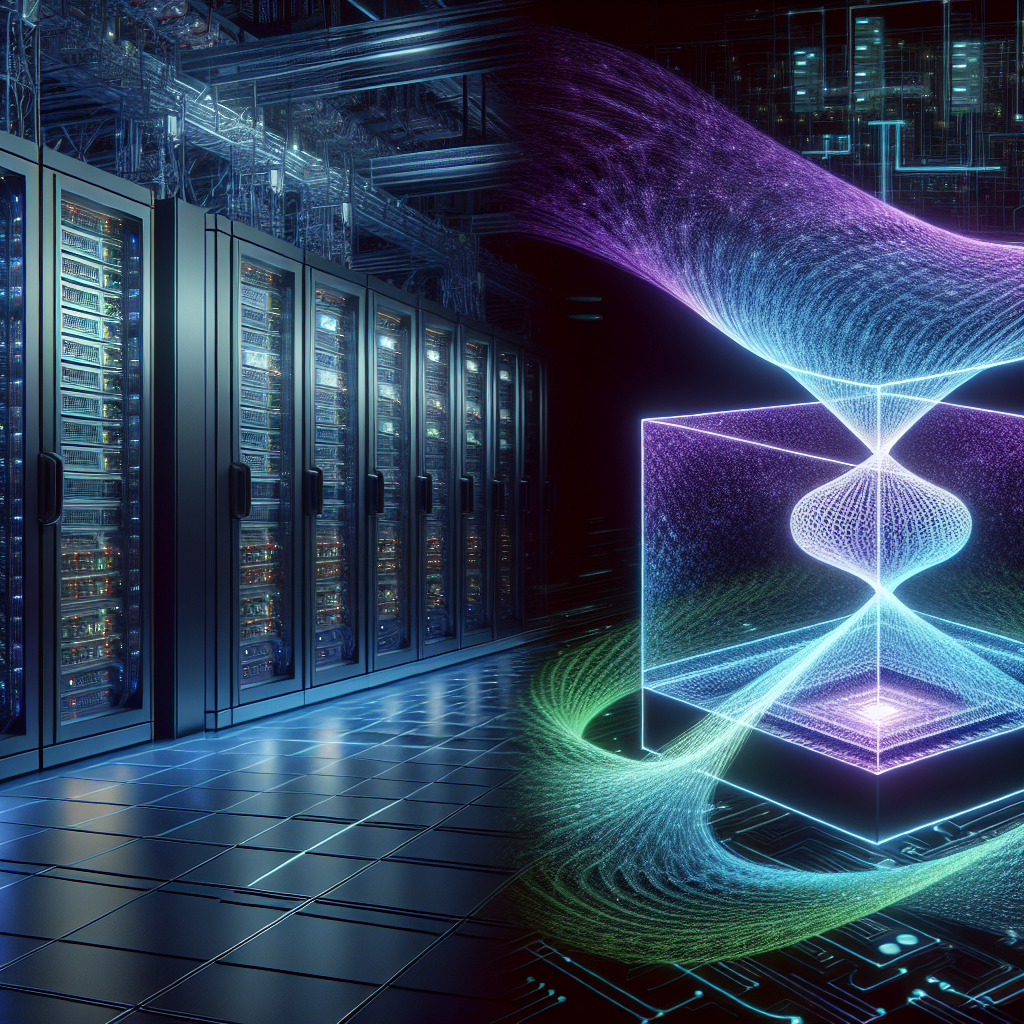Your cart is currently empty!
Tag: Supercomputers

Advancements in High Performance Computing: From Supercomputers to Quantum Computing
High performance computing (HPC) has come a long way since the days of massive supercomputers that filled entire rooms. Today, advancements in HPC are pushing the boundaries of what is possible in terms of speed, efficiency, and complexity.One of the most exciting developments in HPC is the rise of quantum computing. Quantum computers use principles of quantum mechanics to perform calculations at speeds that are exponentially faster than traditional computers. This has the potential to revolutionize fields such as cryptography, drug discovery, and weather forecasting.
Another key advancement in HPC is the development of more energy-efficient systems. As the demand for computational power continues to grow, it is becoming increasingly important to find ways to reduce the energy consumption of these systems. New technologies such as liquid cooling, low-power processors, and energy-efficient data centers are helping to make HPC more sustainable.
In addition to quantum computing and energy efficiency, there have been significant advancements in the software and algorithms used in HPC. Machine learning and artificial intelligence are being integrated into HPC systems to improve performance and enable new applications. These technologies are helping researchers and scientists to analyze vast amounts of data and solve complex problems more quickly and accurately.
One area where these advancements are having a major impact is in the field of scientific research. HPC is enabling researchers to simulate complex systems, such as climate models or protein structures, with a level of detail and accuracy that was previously impossible. This is leading to new discoveries and breakthroughs in a wide range of fields, from medicine to materials science.
Overall, the advancements in high performance computing are opening up new possibilities and pushing the boundaries of what is possible in terms of computational power. From supercomputers to quantum computing, these technologies are revolutionizing the way we approach complex problems and are shaping the future of science and technology.

From Servers to Supercomputers: How Fujitsu is Pioneering the Next Generation of Technology
From servers to supercomputers, Fujitsu is at the forefront of pioneering the next generation of technology. With a long history of innovation and a commitment to pushing the boundaries of what is possible, Fujitsu is leading the way in developing cutting-edge solutions that are shaping the future of computing.One area where Fujitsu is making significant strides is in the development of supercomputers. These powerful machines are essential for tackling complex problems in fields such as weather forecasting, drug discovery, and climate modeling. Fujitsu’s supercomputers are among the fastest and most advanced in the world, capable of performing trillions of calculations per second.
One of Fujitsu’s most notable achievements in the supercomputing space is the development of the Fugaku supercomputer. Fugaku, which is currently the fastest supercomputer in the world, is being used for a wide range of applications, from simulating the spread of infectious diseases to designing new materials for use in advanced technologies.
In addition to supercomputers, Fujitsu is also a leader in the development of servers and data center solutions. With the increasing demand for cloud computing and big data analytics, there is a growing need for powerful and efficient servers that can handle the massive amounts of data being generated every day. Fujitsu’s servers are designed to be fast, reliable, and scalable, making them an ideal choice for businesses and organizations of all sizes.
Fujitsu’s commitment to innovation extends beyond hardware to software and services as well. The company is constantly developing new technologies and solutions to help its customers stay ahead of the curve in a rapidly evolving digital landscape. From artificial intelligence to blockchain, Fujitsu is leveraging the latest advancements in technology to drive digital transformation and create new opportunities for growth.
Overall, Fujitsu’s dedication to pushing the boundaries of technology and driving innovation is what sets it apart as a leader in the industry. With a proven track record of delivering cutting-edge solutions that address the most pressing challenges of our time, Fujitsu is paving the way for a brighter future powered by technology. Whether it’s supercomputers, servers, or software, Fujitsu is shaping the next generation of technology and helping to build a more connected and intelligent world.

The Evolution of High Performance Computing: From Supercomputers to the Cloud
High performance computing (HPC) has come a long way since the days of massive supercomputers housed in specialized facilities. Today, with the advent of cloud computing, HPC has evolved to become more accessible, flexible, and cost-effective than ever before.Supercomputers were once the pinnacle of HPC, capable of performing complex calculations and simulations at speeds that were previously unimaginable. These massive machines required dedicated facilities, specialized cooling systems, and a small army of technicians to operate and maintain. While supercomputers are still utilized for certain high-demand applications, such as weather forecasting and nuclear simulations, they are no longer the only option for high performance computing.
The rise of cloud computing has revolutionized the way HPC is delivered and consumed. Cloud-based HPC solutions offer the same level of performance as traditional supercomputers, but with the added benefits of scalability, on-demand access, and cost-efficiency. Users can now access HPC resources over the internet, paying only for the computing power and storage they need, when they need it.
One of the key advantages of cloud-based HPC is its scalability. With traditional supercomputers, users were limited by the physical constraints of the machine. If more computing power was needed, it often required expensive upgrades or the purchase of additional hardware. In contrast, cloud-based HPC allows users to easily scale their computing resources up or down as needed, without the need for costly hardware investments.
Another benefit of cloud-based HPC is its flexibility. Users can access HPC resources from anywhere in the world, using any device with an internet connection. This flexibility enables researchers, scientists, and engineers to collaborate on projects in real-time, regardless of their physical location. Additionally, cloud-based HPC solutions often come with a wide range of software tools and applications, making it easier for users to get started on their projects without the need for extensive setup or configuration.
Cost-efficiency is also a major advantage of cloud-based HPC. With traditional supercomputers, organizations had to make significant upfront investments in hardware, facilities, and personnel. Cloud-based HPC eliminates these costs, allowing organizations to pay only for the resources they use, on a pay-as-you-go basis. This makes HPC more accessible to a wider range of users, including small businesses, startups, and educational institutions.
In conclusion, the evolution of high performance computing from supercomputers to the cloud has democratized access to powerful computing resources. Cloud-based HPC offers scalability, flexibility, and cost-efficiency, making it an attractive option for a wide range of users. As technology continues to advance, we can expect to see even more innovations in the field of HPC, further expanding its capabilities and impact on society.

The Evolution of High Performance Computing: From Supercomputers to Cloud Computing
High performance computing (HPC) has come a long way since its inception, evolving from massive supercomputers to the more flexible and scalable cloud computing solutions we see today. This evolution has been driven by advances in technology, changes in computing needs, and the increasing demand for faster and more efficient processing power.The first supercomputers were developed in the 1960s and 1970s, with machines like the CDC 6600 and the Cray-1 leading the way in terms of processing speed and power. These supercomputers were massive, expensive, and required specialized facilities to operate, making them accessible only to a select few organizations with the resources to afford them.
As technology advanced, supercomputers became more powerful and more widely available, leading to the development of high performance computing clusters that could harness the processing power of multiple machines working in parallel. These clusters allowed for faster processing speeds and greater scalability, but they still required significant resources and expertise to set up and maintain.
The advent of cloud computing in the early 2000s changed the landscape of high performance computing, offering a more flexible and cost-effective solution for organizations looking to harness the power of massive computing resources. Cloud computing allows users to access computing power and storage on-demand, without the need to invest in expensive hardware or build and maintain their own infrastructure.
Cloud computing also offers increased scalability, allowing organizations to easily scale up or down their computing resources based on their needs. This flexibility has made cloud computing an attractive option for a wide range of industries, from scientific research to financial services to entertainment.
In addition to its cost-effectiveness and scalability, cloud computing also offers greater accessibility, allowing users to access computing resources from anywhere with an internet connection. This has democratized high performance computing, making it accessible to a wider range of organizations and individuals than ever before.
As we look to the future, the evolution of high performance computing is likely to continue, with advances in technology driving even greater processing power and efficiency. The rise of artificial intelligence, machine learning, and big data analytics will continue to drive the demand for high performance computing solutions, and cloud computing is poised to play a key role in meeting these demands.
Overall, the evolution of high performance computing from supercomputers to cloud computing has been a testament to the power of technology to transform the way we work, communicate, and innovate. With cloud computing offering greater flexibility, scalability, and accessibility than ever before, the future of high performance computing looks brighter than ever.

The Evolution of High-Performance Computing: From Supercomputers to Cloud Computing
High-performance computing (HPC) has come a long way since its inception, evolving from massive supercomputers to the more accessible and scalable cloud computing model. The evolution of HPC has revolutionized the way businesses and organizations handle complex computational tasks, enabling them to process large amounts of data quickly and efficiently.Supercomputers were once the pinnacle of HPC technology, with their massive processing power and high-speed connections allowing for groundbreaking scientific research and simulations. These powerful machines were typically housed in specialized data centers and required significant resources to operate and maintain. However, as technology advanced and demands for more accessible computing power grew, a shift towards cloud computing began to take shape.
Cloud computing offers a more flexible and cost-effective solution for HPC needs, allowing organizations to access high-performance computing resources on-demand through the internet. This model eliminates the need for expensive hardware investments and provides scalability to meet varying computational needs. With cloud computing, users can quickly spin up virtual machines with high-performance capabilities, making it easier to handle complex tasks without the need for dedicated hardware.
The evolution of HPC from supercomputers to cloud computing has opened up new possibilities for businesses and organizations across various industries. Researchers can now conduct complex simulations and analysis in a fraction of the time it would have taken with traditional computing methods. Financial institutions can process massive amounts of data in real-time to make informed decisions, while healthcare organizations can analyze patient data to improve treatments and outcomes.
The scalability and flexibility of cloud computing have also democratized access to high-performance computing, allowing smaller businesses and startups to leverage powerful computing resources without the need for a substantial upfront investment. This has leveled the playing field and enabled organizations of all sizes to compete in a data-driven world.
As technology continues to advance, the evolution of high-performance computing is set to continue. Emerging technologies such as quantum computing and edge computing are already reshaping the landscape of HPC, offering new possibilities for even faster and more efficient processing capabilities. The future of HPC is bright, with endless opportunities for innovation and discovery on the horizon.
